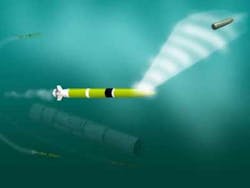Leidos to develop acoustic countermeasure to provide torpedo defense for Navy submarine fleet
WASHINGTON – U.S. Navy undersea warfare experts are asking Leidos Inc. in Reston, Va., to develop an advanced active acoustic countermeasure to help defend U.S. and allied submarine forces against modern acoustic-homing torpedoes.
Officials of the Naval Sea Systems Command in Washington announced a $13.9 million contract to Leidos on Thursday to design, build, and test an acoustic device countermeasure (ADC) called the ADC MK5.
This torpedo-defense countermeasure will generate noise to deceive the sonar guidance systems of incoming torpedoes that are homing-in on the sounds the target submarines are making, as well as the acoustic returns of active sonar pings.
This contract calls for Leidos to design and develop ADC MK5 torpedo defense developmental devices, as well as provide technical and non-recurring engineering services, This includes software and hardware development. The contract has options that could increase its value to $36.1 million.
The ADC MK5 project is part of the Navy's Next-Generation Countermeasure (NGCM) program to replace existing ADC MK 3 submarine acoustic countermeasures systems.
The ADC MK5 is to be a 3-inch-diameter expendable device that submarines launch from external launchers have advanced features that submarines can employ as static or mobile devices with adaptive countermeasure (ACM) technology.
The contract to Leidos is a follow-on to research contracts awarded in late 2010 to Ultra Electronics Ocean Systems in Braintree, Mass., and to the Argon ST subsidiary of the Boeing Co. in Fairfax, Va., to develop the Navy's NGCM anti-torpedo submarine defense system.
The NGCM ADC MK5 will have acoustic communications links to connect separate countermeasures devices to enable group behavior to defeat incoming torpedoes. It will be launched in-groups of as many six units -- some of which will act as stationary broadcast jammers, while others will be mobile and function as sophisticated decoys.
The ADC MK5 countermeasures will have receivers that can operate in full duplex mode, and an acoustic communication link will pass tactical information and updates among the deployed countermeasures, submarines, and surface ships.
Related: Navy researchers survey industry for underwater acoustic projector for LCS torpedo defense
The ADC MK5 will be re-programmable to operate together with U.S. and allied torpedoes or anti-torpedo systems, and will be able to change tactics in response to changing tactical or environmental conditions via the acoustic communication link.
The countermeasures will have advanced tactical embedded processors and a built-in threat torpedo classifier. The system's new technologies will include mobile countermeasure operations and tactics; acoustic communications; group behavior and the ability to work against incoming torpedoes cooperatively; the ability to classify incoming torpedoes; full-duplex receive and transmit sensor capability; and single-crystal transducers.
The NGCM program seeks to insert new countermeasure technologies into submarine defenses against threat acoustic-homing torpedoes. On this contract Leidos will do the work in De Leon Springs, Fla.; Reston, Va.; and Worthington, Ohio, and should be finished by February 2020.
For more information contact Leidos online at www.leidos.com, or Naval Sea Systems Command at www.navsea.navy.mil.
Ready to make a purchase? Search the Military & Aerospace Electronics Buyer's Guide for companies, new products, press releases, and videos

